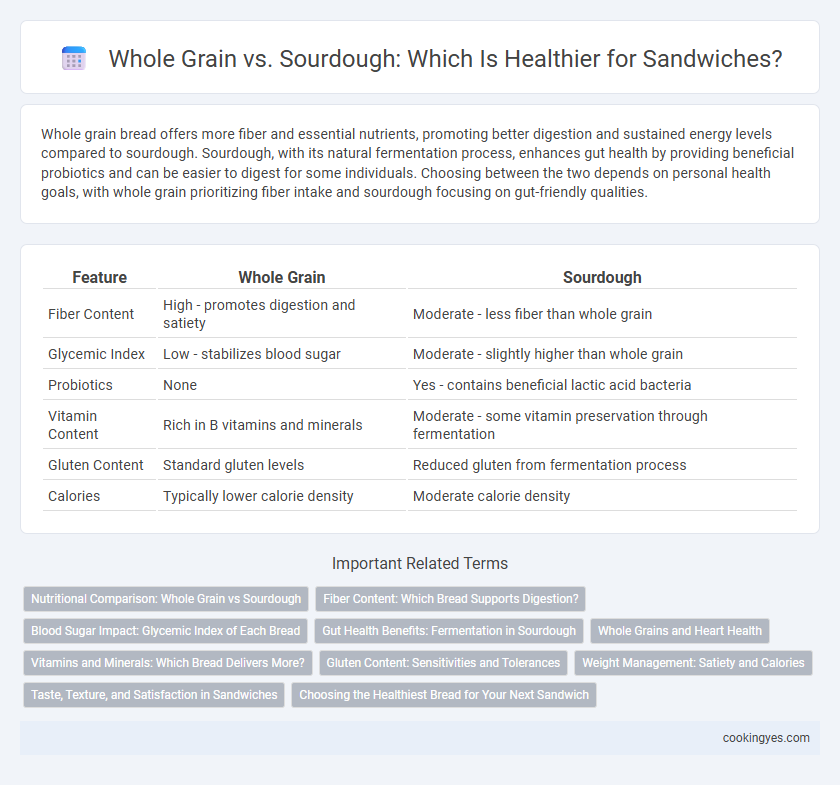Whole grain bread offers more fiber and essential nutrients, promoting better digestion and sustained energy levels compared to sourdough. Sourdough, with its natural fermentation process, enhances gut health by providing beneficial probiotics and can be easier to digest for some individuals. Choosing between the two depends on personal health goals, with whole grain prioritizing fiber intake and sourdough focusing on gut-friendly qualities.
Table of Comparison
| Feature | Whole Grain | Sourdough |
|---|---|---|
| Fiber Content | High - promotes digestion and satiety | Moderate - less fiber than whole grain |
| Glycemic Index | Low - stabilizes blood sugar | Moderate - slightly higher than whole grain |
| Probiotics | None | Yes - contains beneficial lactic acid bacteria |
| Vitamin Content | Rich in B vitamins and minerals | Moderate - some vitamin preservation through fermentation |
| Gluten Content | Standard gluten levels | Reduced gluten from fermentation process |
| Calories | Typically lower calorie density | Moderate calorie density |
Nutritional Comparison: Whole Grain vs Sourdough
Whole grain bread offers higher fiber content, essential vitamins like B-complex, and minerals such as magnesium and zinc, contributing to improved digestion and heart health in sandwiches. Sourdough bread contains beneficial probiotics and organic acids that aid gut health and enhance nutrient absorption despite having slightly lower fiber than whole grain. Choosing whole grain maximizes fiber and micronutrient intake, while sourdough supports digestive benefits through natural fermentation.
Fiber Content: Which Bread Supports Digestion?
Whole grain bread is rich in dietary fiber, particularly insoluble fiber, which enhances digestion by promoting regular bowel movements and maintaining gut health. Sourdough bread, while lower in fiber, contains beneficial probiotics and organic acids that may support digestion by improving nutrient absorption and fostering a healthy gut microbiome. For optimal fiber intake and digestive benefits, whole grain bread is generally the superior choice for sandwiches.
Blood Sugar Impact: Glycemic Index of Each Bread
Whole grain bread typically has a lower glycemic index (GI) ranging from 50 to 55, resulting in a more gradual blood sugar rise compared to sourdough, which usually has a GI between 53 and 66 depending on fermentation and flour type. The natural acids and fermentation process in sourdough can moderate glucose response, potentially improving blood sugar control despite its variable GI. Choosing whole grain or sourdough bread for sandwiches can influence post-meal blood glucose levels, important for managing insulin sensitivity and reducing diabetes risk.
Gut Health Benefits: Fermentation in Sourdough
Sourdough bread offers significant gut health benefits due to its natural fermentation process, which promotes the growth of beneficial probiotics and enhances nutrient absorption. The lactic acid bacteria in sourdough help reduce phytic acid levels, improving mineral bioavailability and supporting digestive wellness. Whole grain bread provides fiber essential for digestion, but the probiotics from sourdough fermentation offer a unique advantage for maintaining a healthy gut microbiome.
Whole Grains and Heart Health
Whole grain bread is rich in dietary fiber, antioxidants, and essential nutrients like magnesium and potassium, which contribute significantly to heart health by reducing cholesterol levels and improving blood pressure. Consuming whole grain sandwiches regularly helps lower the risk of cardiovascular disease by promoting better arterial function and reducing inflammation. Unlike sourdough, which varies in nutritional content, whole grain bread consistently delivers heart-protective benefits through its complex carbohydrates and phytochemicals.
Vitamins and Minerals: Which Bread Delivers More?
Whole grain bread offers higher amounts of essential vitamins such as B-complex vitamins, including niacin, thiamine, and riboflavin, which support energy metabolism and brain function. It also contains more minerals like iron, magnesium, and zinc, critical for oxygen transport, muscle function, and immune health. Sourdough bread provides some B vitamins and minerals, but the fermentation process mainly enhances nutrient absorption rather than increasing the total vitamin and mineral content.
Gluten Content: Sensitivities and Tolerances
Whole grain bread contains more gluten compared to sourdough, making it less suitable for individuals with gluten sensitivities or mild intolerances. Sourdough undergoes natural fermentation, which helps break down gluten proteins, potentially reducing gluten content and improving digestibility for sensitive individuals. Choosing sourdough over whole grain can aid those with gluten sensitivities in enjoying sandwiches with lower gluten exposure.
Weight Management: Satiety and Calories
Whole grain sandwiches offer higher fiber content, promoting greater satiety and aiding in weight management by reducing overall calorie intake. Sourdough bread, while lower in fiber, contains beneficial probiotics that may improve digestion but generally has a similar calorie count to whole grain. Choosing whole grain for sandwiches supports longer-lasting fullness and controlled calorie consumption, essential for effective weight management.
Taste, Texture, and Satisfaction in Sandwiches
Whole grain bread offers a nutty, rich flavor with a dense, hearty texture that enhances sandwich satisfaction through a more substantial bite and greater nutritional benefits like fiber and vitamins. Sourdough features a tangy, slightly sour taste with a chewy yet airy texture, promoting better digestion and a unique flavor complexity that complements both savory and sweet fillings. Choosing between whole grain and sourdough depends on whether you prioritize robust nutrient content and a filling texture or a distinct, tangy flavor profile with lighter chewiness in your sandwich experience.
Choosing the Healthiest Bread for Your Next Sandwich
Whole grain bread offers higher fiber content, essential vitamins, and antioxidants that support digestive health and stable blood sugar levels compared to sourdough. Sourdough contains beneficial probiotics and easier-to-digest nutrients due to its fermentation process, which can improve gut health and reduce gluten sensitivity. Choosing whole grain or sourdough depends on individual nutritional goals, with whole grain providing more fiber and sourdough offering better digestion and probiotic benefits.
Whole Grain vs Sourdough for sandwich health Infographic

 cookingyes.com
cookingyes.com